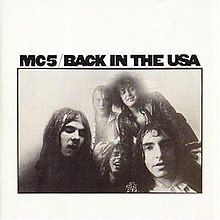Back in the USA (album)
| Back in the USA | ||||
|---|---|---|---|---|
 |
||||
| Studio album by MC5 | ||||
| Released | January 15, 1970 | |||
| Recorded | 1969 | |||
| Studio | GM Studios, East Detroit, United States | |||
| Genre | Hard rock, proto-punk, rock and roll | |||
| Length | 28:08 | |||
| Label | Atlantic | |||
| Producer | Jon Landau | |||
| MC5 chronology | ||||
|
||||
| Professional ratings | |
|---|---|
| Review scores | |
| Source | Rating |
| AllMusic | |
| Robert Christgau | A− |
| Rolling Stone | mixed |
Back in the USA is the debut studio album (and second album overall, following 1969's live album Kick Out the Jams) by American rock band MC5.
The central focus of the album is the band's movement away from the raw, thrashy sound pioneered and captured on their first release, the live album Kick Out the Jams (1969). This was due in part to producer Jon Landau's distaste for the rough psychedelic rock movement, and his adoration for the straightforward rock and roll of the 1950s.
Landau, who originally wrote for Rolling Stone magazine, was looking to get more involved in actual music production. Becoming close with Atlantic Records executive Jerry Wexler was his chance and led Landau to the politically radical MC5, who had just been picked up by Atlantic after being dropped from Elektra Records in 1969 – ironically, the Kinney National Company (later known as Time Warner), parent of Atlantic, would acquire Elektra in the same year of this album's release; both labels are now part of the Warner Music Group (now a separate company from TW), through the Atlantic Records Group.
The opening track is a cover of the classic hit "Tutti Frutti" by Little Richard. "Let Me Try" is a ballad. "The American Ruse" attacks what the Detroit quintet saw as the hypocritical idea of freedom espoused by the US government, and "The Human Being Lawnmower" expresses opposition to the US involvement in the Vietnam War. The last song on the album, which is the title track, is a cover of Chuck Berry's 1959 single "Back in the U.S.A.".
...
Wikipedia
